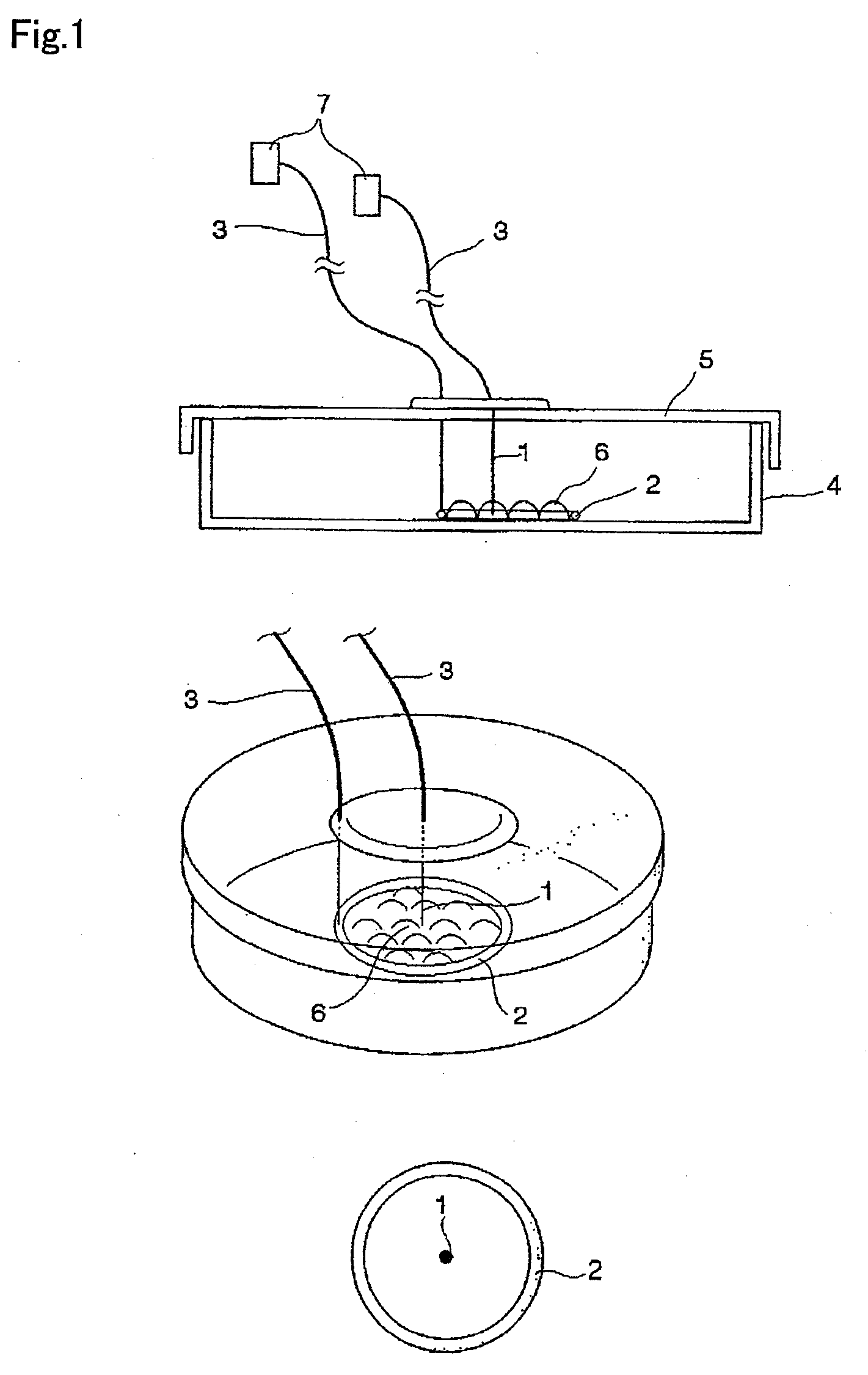Cell stimulating device and cell stimulating method
- Summary
- Abstract
- Description
- Claims
- Application Information
AI Technical Summary
Benefits of technology
Problems solved by technology
Method used
Image
Examples
example 1
Preparation of Antibodies that Specifically Recognize Secretory Neuregulin
(1) Design of Antigen Hapten Peptides
[0052]In order to prepare anti-peptide antibodies that complement a limited proteolytic reaction, information concerning the cleavage site of a target substrate protein is necessary. In this example, a peptide in which a cysteine residue is added to a short peptide (5 mer or 6 mer) containing the C-terminal of secretory neuregulin was synthesized, and was used as a hapten. To be more precise, a mixed peptide of Cys-Glu-Leu-Tyr-Gln and Cys-Glu-Leu-Tyr-Gln-Lys was used as an antigen.
(2) Reagents Used:
[0053]Synthesized hapten peptide
[0054]KLH (keyhole limpet hemocyanin) in 50% glycerol (approximately 80% mg / ml) (Calbiochem)
[0055]DMFA (dimethylformamide)
[0056]MBS (m-maleimidobenzoyl-N-hydroxysuccinimide ester) (Pierce)
[0057]Gel filtration column (Pharmacia PD-10)
[0058]50 mM sodium phosphate buffer (pH 7.5)
[0059]100 mM sodium phosphate buffer (pH 7.2)
Immunization:
[0060]Freund's ...
example 2
Pathological Action Mechanism of Neuregulin
(Method)
(1) Cell Preparation
[0074]Cerebellar granule cells and nerve cells of the pontine nuclei were prepared by the standard method from P7 and E18 BALB / c mice, respectively. 7 DIV cultures were used for PMA and electrical stimulation in both types of cells. The granule cells were cultured for 1 to 21 days in vitro under conditions including the presence of 10 mM KCl for quantification of receptor subunit expression. The pontine nuclei neurons were cultured with DMEM (Gibco BRL) containing 10% horse serum for 1 or 2 days. The neurons were then maintained with Neurobasal medium (Gibco BRL) supplemented with B-27 (Gibco BRL). The culture products were fed with a medium consisting of Neurobasal medium (Gibco BRL) supplemented with B-27 (Gibro BRL). The full length of the NRG plasmid containing the GFP tag and the GFP vector (pEGFP, Clonthech) were each transfected by Lipofectamine (TM) 2000 (Gibco BRL) (transfection efficiency of pontine nuc...
example 3
Analysis of Expression Mechanism of Transmission Receptor
(Method) Real-Time Quantitative Analysis of NMDA and GABAA Receptor Subunits
[0086]After electrical stimulation, a real-time quantitative analysis (ABI prism 7700, Perkin Elmer) was performed. Primers and TaqMan probes were designed using Primer Express (PE Biosystems). Each PCR product amplified by a different primer was found as a single band on agarose gel. The products were confirmed by direct sequencing. No primer used crossed with any other genes. For the pharmacological experiments, TTX (1 μM, Tocris), D-AP5 (50 μM, Tocris), MK801 (25 μM, Tocris), CNQX (10 μM, Tocris), Cd (100 μM, Wako Inc.), and EGTA (1 mM, Sigma) were used.
(Results) The Expression of NMDA and GABAA Receptor Subunits Controlled by Electrical Stimulation
[0087]The patterns of electrical activities whereby the expression of an NMDA receptor subunit and that of a GABAA receptor subunit can be controlled were examined. With the use of a real-time quantitativ...
PUM
 Login to View More
Login to View More Abstract
Description
Claims
Application Information
 Login to View More
Login to View More - R&D
- Intellectual Property
- Life Sciences
- Materials
- Tech Scout
- Unparalleled Data Quality
- Higher Quality Content
- 60% Fewer Hallucinations
Browse by: Latest US Patents, China's latest patents, Technical Efficacy Thesaurus, Application Domain, Technology Topic, Popular Technical Reports.
© 2025 PatSnap. All rights reserved.Legal|Privacy policy|Modern Slavery Act Transparency Statement|Sitemap|About US| Contact US: help@patsnap.com



